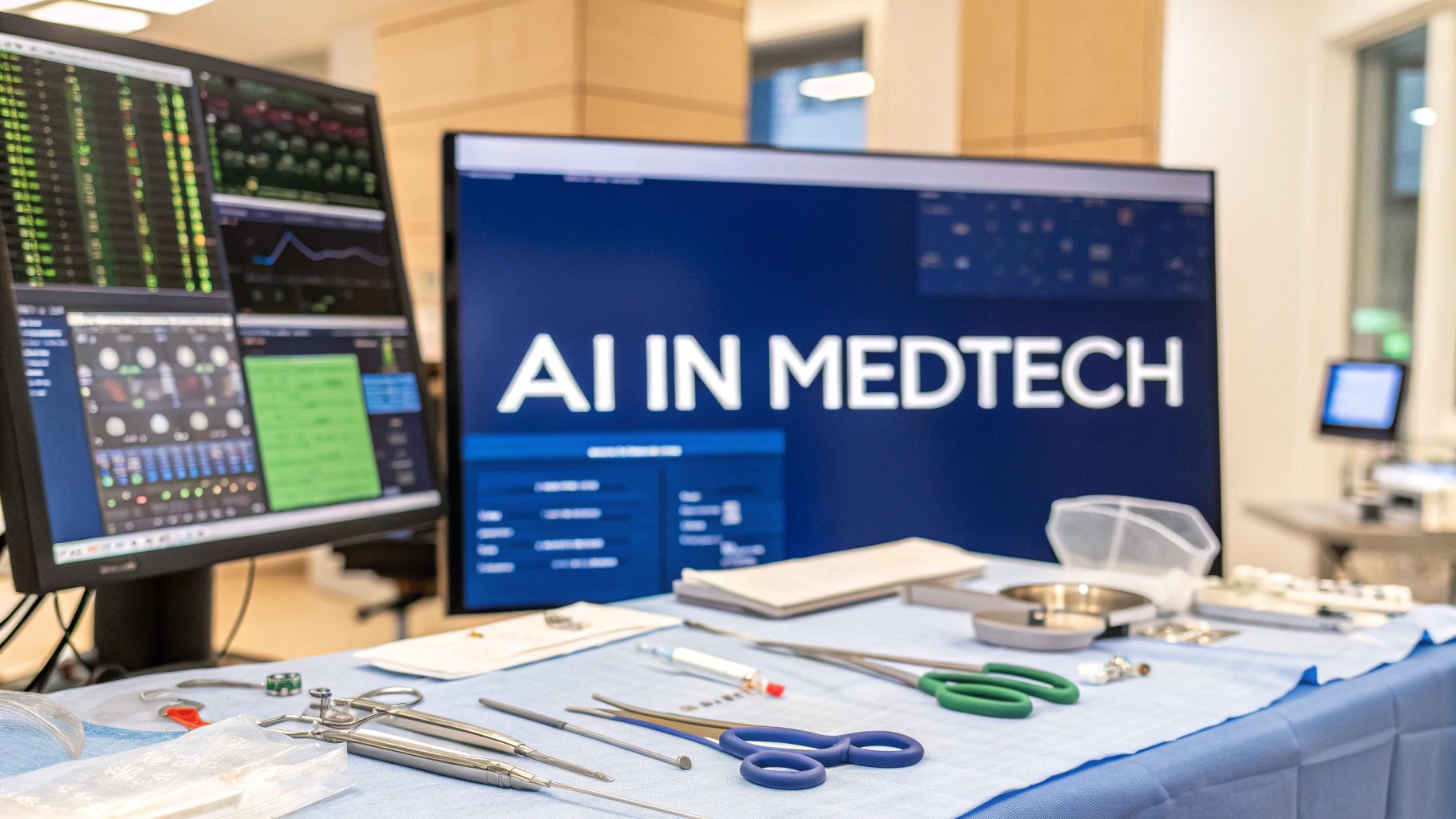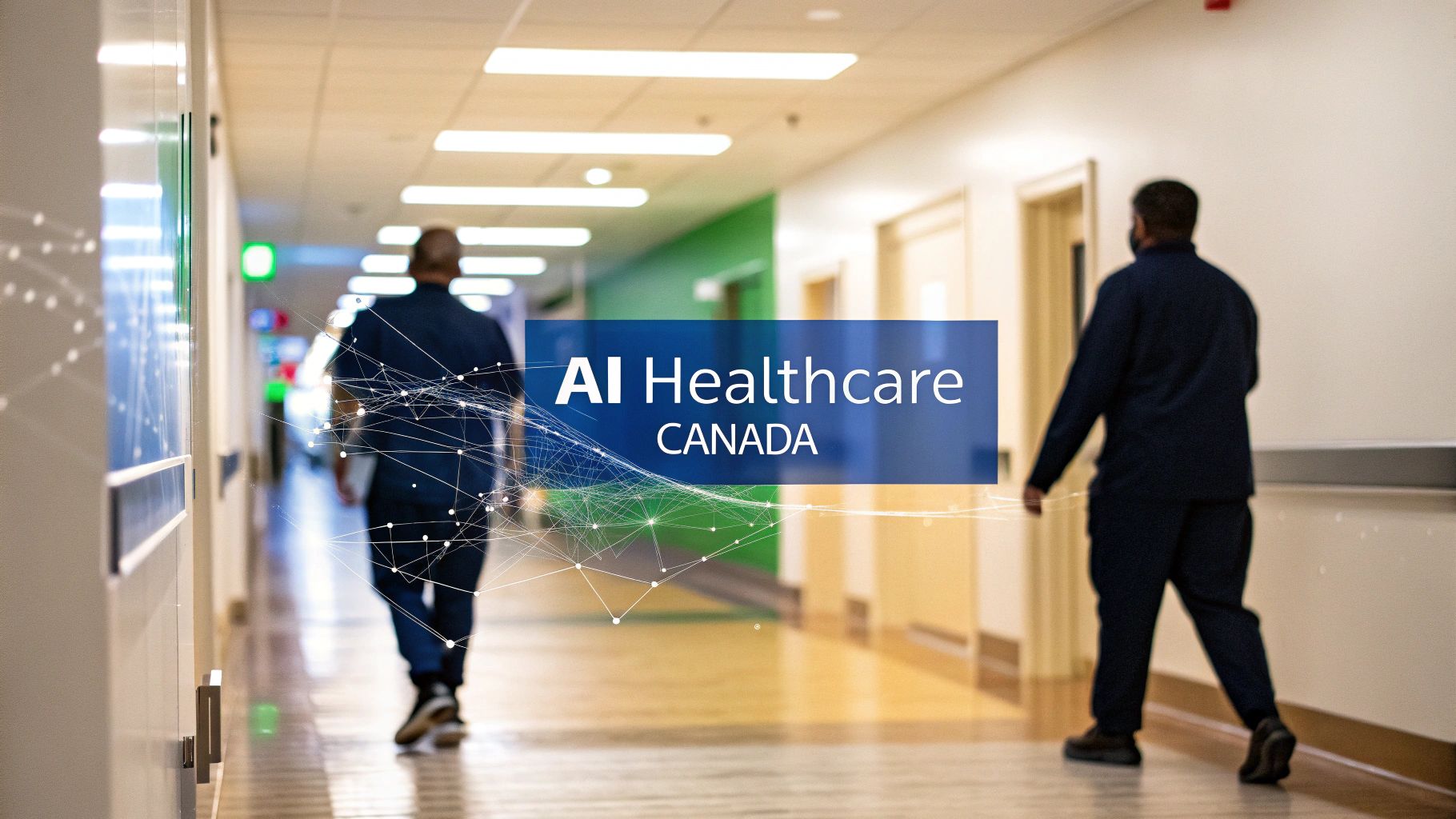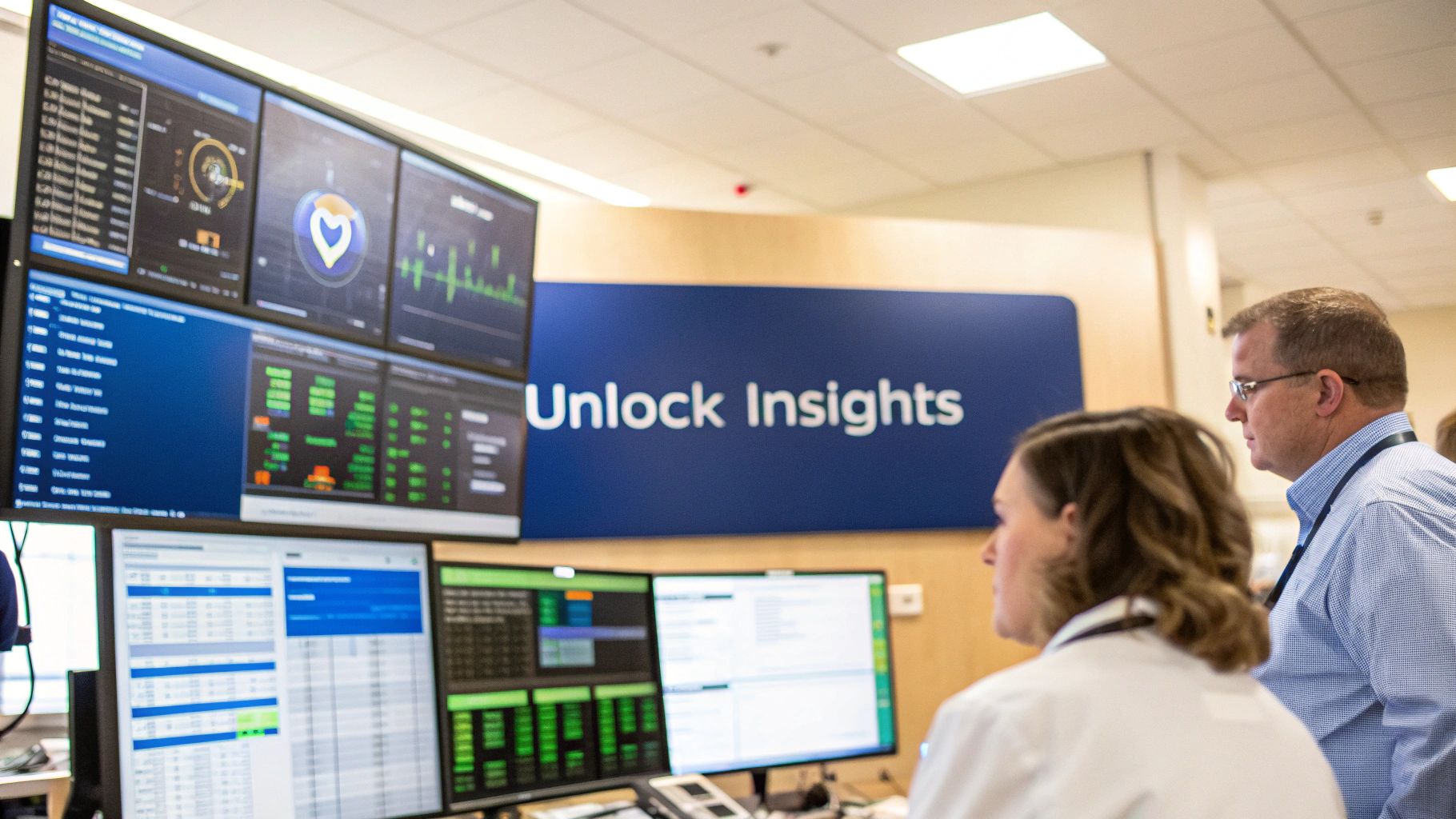At its heart, AI in MedTech is about building a smarter, more responsive healthcare system. These aren't just fancy new tools; artificial intelligence applications are becoming powerful partners for medical professionals. They help anticipate patient needs, personalize treatments, and make complex hospital operations run more smoothly.
The New Digital Nervous System in Healthcare
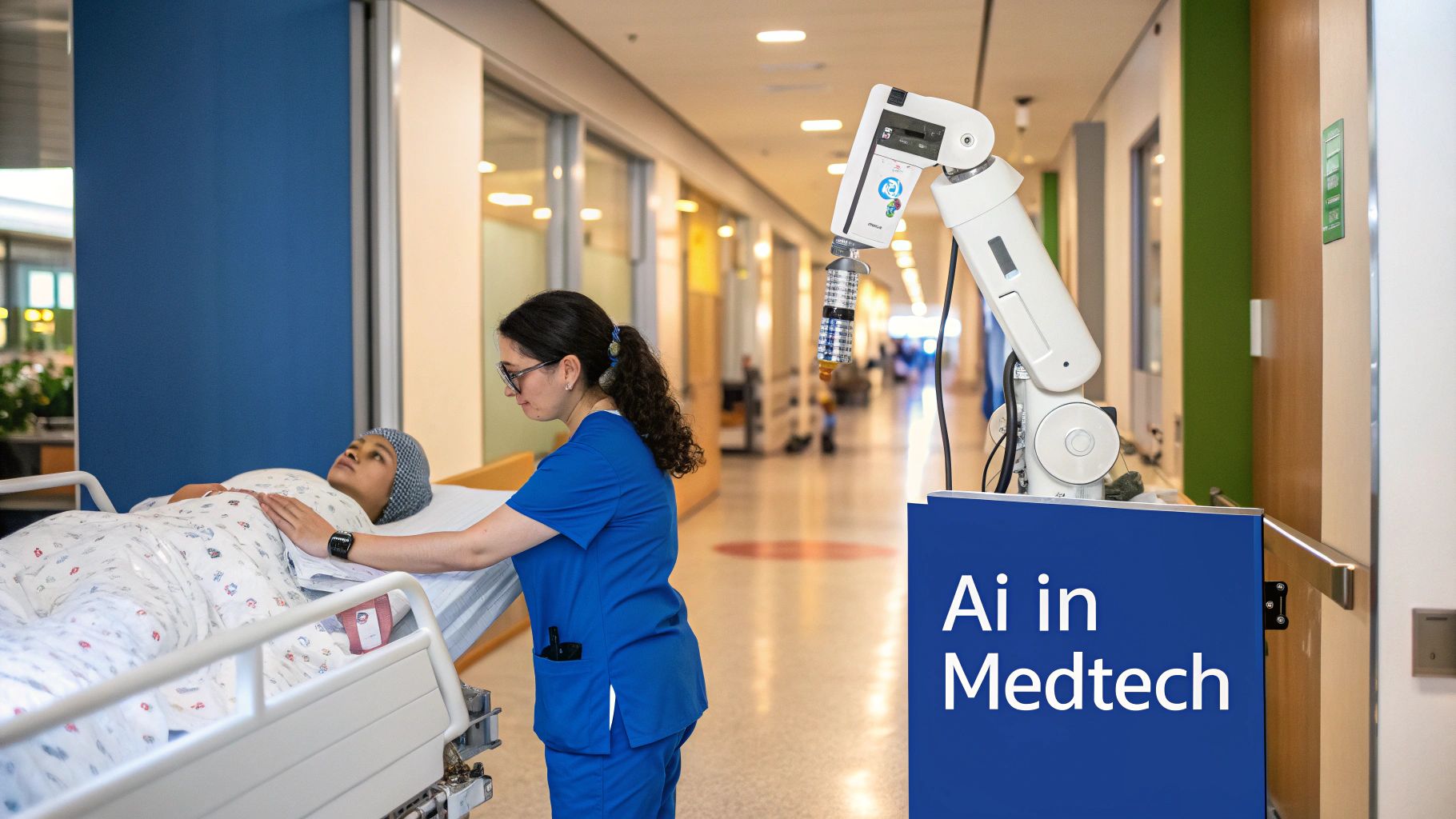
Think of the healthcare ecosystem as a digital nervous system. That's the core idea behind AI in MedTech. It’s a network that pulls together countless data points, from diagnostic scans and lab results to patient histories and real-time vital signs, and makes sense of it all.
Just like our own nervous system processes information to coordinate our actions, AI algorithms sift through this massive flow of medical data. They spot patterns, predict outcomes, and support clinical decisions in real time. This isn't science fiction; it’s a practical solution being used today to tackle some of Canada's biggest healthcare headaches, like long wait times and diagnostic backlogs.
Augmenting Human Expertise
It’s a common myth that AI is here to replace doctors. The truth is much more collaborative. AI in medical technology is designed to augment and enhance the incredible skills and intuition of healthcare professionals. It takes on the heavy lifting of data processing, which frees up clinicians to focus on what they do best: providing compassionate, expert patient care.
A perfect example is in medical imaging. An AI can analyze thousands of scans in the time it takes a radiologist to review just one, flagging subtle anomalies that a human eye might miss. This kind of partnership raises the standard of care, leading to earlier diagnoses and more effective treatments for patients across the country.
The real magic of AI in MedTech is its ability to transform mountains of disconnected data into actionable intelligence. It gives clinicians a deeper, more complete picture of a patient's health, shifting the focus from reactive to proactive care.
Connecting the Dots in Patient Care
A patient's journey through the healthcare system can be fragmented, involving many different specialists and departments. AI is the glue that connects these pieces, ensuring information flows seamlessly. For example, AI-driven EHR solutions can intelligently organize complex patient records, highlighting the most critical information for each provider along the way. You can explore how these smart systems are improving data management in our guide on AI-driven EHR solutions for modern healthcare.
This connected approach has some clear benefits:
-
Reduced Administrative Burden: Automating routine tasks, such as scheduling and data entry, allows medical staff to spend more time with patients.
-
Enhanced Decision-Making: Clinicians gain insights backed by data, enabling them to choose the most effective treatment plans with greater confidence.
-
Improved Patient Outcomes: A coordinated system minimizes the risk of medical errors and ensures every patient receives consistent, high-quality care.
By building this digital nervous system, AI is clearing a path toward a healthcare future that is more efficient, precise, and centred around the patient.
How AI Tackles Real-World Healthcare Challenges

The promise of AI in MedTech feels a lot more real when you see how it tackles the frustrating, everyday problems that patients and doctors face. We’ve all heard about the long wait times for specialist appointments and diagnostic tests in Canada. These aren't just minor annoyances, but genuine roadblocks to getting timely care. This is exactly where AI stops being a buzzword and becomes a practical, problem-solving tool.
Instead of just layering more technology onto an already crowded system, AI gives us a way to work smarter. It gets right to the heart of what causes delays, like administrative overload and clumsy resource management. By taking over routine tasks and offering insights based on hard data, AI helps clear the way for healthcare professionals to do what they do best: focus on their patients.
Slashing Diagnostic Delays with Intelligent Imaging
One of the most powerful applications of AI is in medical imaging. Radiologists and pathologists are facing a growing mountain of complex scans, like MRIs, CTs, and X-rays, that all need careful analysis. This massive workload inevitably creates backlogs, which means diagnoses get delayed, and so does treatment.
AI-driven diagnostic tools essentially act as a second set of eyes that never gets tired. These algorithms are trained on huge libraries of medical images, learning to spot potential issues with incredible speed and accuracy. They can flag suspicious areas on a scan, helping a radiologist prioritise their work and focus on the most urgent cases first. It doesn’t replace the expert’s final call, but it makes the initial screening process vastly more efficient.
For a patient, this could mean getting critical results back much sooner. For a hospital, it translates to higher throughput and a more effective use of its highly skilled medical teams.
AI's job isn't to make the final diagnosis. It’s to triage and prioritise, making sure the most critical cases get seen first. Think of it as an incredibly sharp assistant who can sort through a mountain of information to find the most important details, fast.
Optimizing Hospital Operations and Shortening Waitlists
Beyond diagnostics, AI is proving invaluable for sorting out the complicated logistics of running a hospital. Inefficient scheduling, unpredictable patient numbers, and endless paperwork are all major reasons we see long wait times for appointments and procedures.
Machine learning models can dig into a hospital's historical data to predict future demand with surprising accuracy. This gives administrators a heads-up on patient surges, allowing them to create better staff schedules and manage bed allocation more effectively. It’s like an advanced air traffic control system for the hospital, making sure resources are flowing smoothly to exactly where they’re needed.
This kind of operational fine-tuning gets right at a core problem in Canadian healthcare. A recent report found that nearly 45% of Canadian patients deal with long wait times, with specialist appointments taking an average of 131 days, almost double the global average. The fallout is serious: 1 in 5 Canadians winds up in the hospital while waiting for care. By using AI to sharpen scheduling and resource planning, healthcare facilities can start chipping away at those daunting waitlists. You can read the full breakdown in the Philips Future Health Index 2025 Canada report.
AI-powered systems can help tackle these bottlenecks head-on:
-
Predicting No-Shows: Algorithms can identify patients who are likely to miss their appointments, which allows staff to proactively offer those slots to others.
-
Automating Scheduling: Smart systems can juggle complex appointment calendars, coordinating patients, doctors, and equipment without the usual back-and-forth.
-
Streamlining Paperwork: AI can automate the transcription of doctors’ notes and the processing of referrals, freeing up precious time for actual patient care.
By fixing these foundational issues, AI in medtech offers a very real way to improve access to care, cut down on the administrative grind, and ultimately let our healthcare system serve patients better.
Exploring Key AI Applications in Medical Technology
When we talk about artificial intelligence in healthcare, it's not one single, magic-bullet technology. It's more like a specialist's toolkit, filled with precise instruments designed for very specific jobs. In the world of medical technology, these tools are already making a real difference in how we diagnose, manage, and even predict diseases. These aren't just futuristic concepts; they're practical solutions that are empowering Canadian doctors and improving patient outcomes today.
This diagram breaks down the main ways AI is being applied across the medical field.
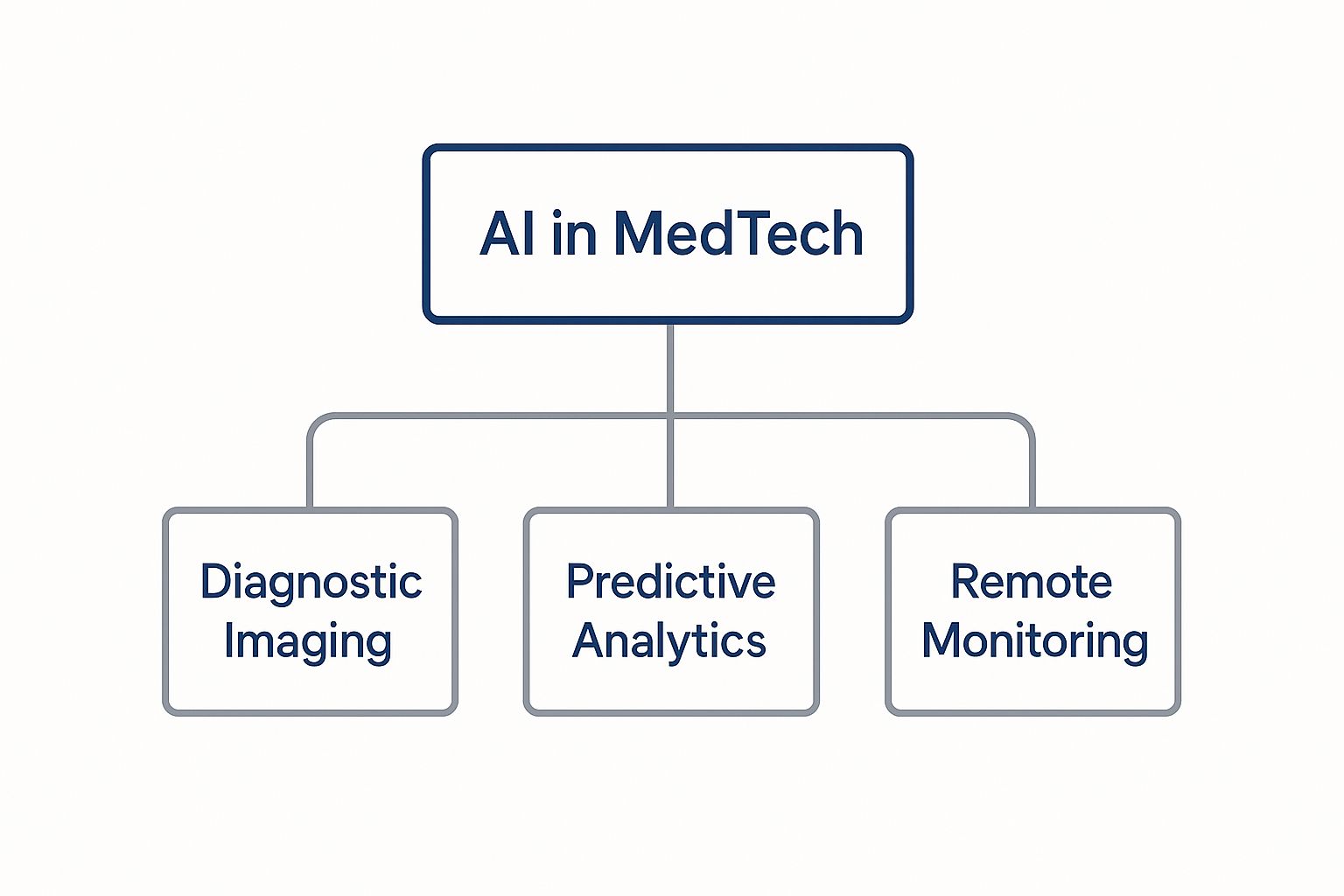
As you can see, AI's role in medtech ranges from direct clinical support, like helping with diagnostics, all the way to big-picture health management through advanced analytics and remote care.
Enhancing Diagnostic Imaging and Accuracy
One of the most established and impactful uses of AI in medtech is in diagnostic imaging. The best way to think of it is as a super-powered assistant for radiologists. An AI algorithm can be trained on millions of medical scans, like X-rays, CT scans, MRIs, and learn to spot tiny patterns or anomalies that might be easy for the human eye to miss, especially after a long and demanding shift.
This isn't about replacing the radiologist's crucial expertise. It's about collaboration. The AI acts as a first-pass filter, flagging areas of potential concern and helping to prioritise the most urgent cases for review. This partnership can slash the time it takes to get a diagnosis, which is absolutely critical for conditions like cancer or neurological disorders, where every day counts.
The real value here is that AI can find the "needle in the haystack" with incredible speed and consistency. It frees up the radiologist to focus their skills on complex interpretations rather than getting bogged down in routine screening.
This technology is already paying dividends. In Canada, AI-assisted diagnostics have hit accuracy rates over 90% in certain medical imaging tasks, a massive step forward for early detection. This progress is part of a larger national effort, backed by a CAD 443 million investment through the Pan-Canadian AI Strategy, to position our country as a global leader in responsible medtech innovation.
Predicting Health Risks Before They Escalate
Beyond just finding existing problems, AI is getting remarkably good at predicting future ones. Using predictive analytics, these systems can sift through enormous datasets of patient information, from electronic health records and lab results to genetics and even lifestyle factors, to pinpoint individuals at high risk for conditions like sepsis, heart failure, or diabetes.
Imagine a hospital system that can automatically flag a patient whose vital signs are showing a subtle but dangerous downward trend. The AI could alert the clinical team hours before a crisis hits. This proactive approach enables early intervention, which can prevent severe complications, shorten hospital stays, and, most importantly, save lives. It marks a fundamental shift from simply reacting to sickness to proactively managing wellness.
Some key examples include:
-
Early Warning Systems: AI models that monitor real-time patient data to predict the onset of acute events like cardiac arrest.
-
Chronic Disease Management: Algorithms that identify patients who are struggling with chronic conditions, allowing healthcare providers to step in with targeted support.
-
Population Health Insights: At a broader level, AI can analyze community health data to help public health officials forecast disease outbreaks and allocate resources where they're needed most.
Streamlining Clinical Workflows and Documentation
The administrative load on clinicians is a huge source of burnout and inefficiency. It's a well-known problem that doctors often spend more time on paperwork than with their patients. AI is providing some much-needed, practical relief by automating these routine but incredibly time-consuming tasks.
A perfect example of this is AI-powered speech-to-text medical transcription. These tools can instantly convert a doctor's spoken notes into accurately formatted text, freeing them from hours of tedious typing and ensuring patient records are always detailed and current. In the same vein, AI can help process insurance claims, manage appointments, and automate referral workflows, making the entire clinic run more smoothly. By taking these administrative chores off their plate, AI gives healthcare professionals their time back to focus on what they do best: caring for patients.
Key AI Applications in Canadian MedTech
To put it all together, here is a quick summary of how these AI applications are directly tackling challenges within the Canadian healthcare system.
|
AI Application Area |
Problem Solved |
Impact on Canadian Healthcare |
|---|---|---|
|
Diagnostic Imaging |
Inconsistent or delayed detection of anomalies in medical scans, and clinician fatigue. |
Faster, more accurate diagnoses; reduces radiologist workload; improves early detection rates for critical diseases. |
|
Predictive Analytics |
Reactive treatment of acute events and chronic disease complications. |
Proactive interventions; prevent hospital readmissions; support population health strategies and resource allocation. |
|
Workflow Automation |
Heavy administrative burden on clinicians, leading to burnout and reduced patient face-time. |
Reduces documentation time; minimises errors; allows clinicians to focus more on direct patient care and complex decision-making. |
Ultimately, these applications are not just about new technology; they're about creating a more efficient, proactive, and patient-centred healthcare system for all Canadians.
Navigating the Regulatory and Ethical Maze
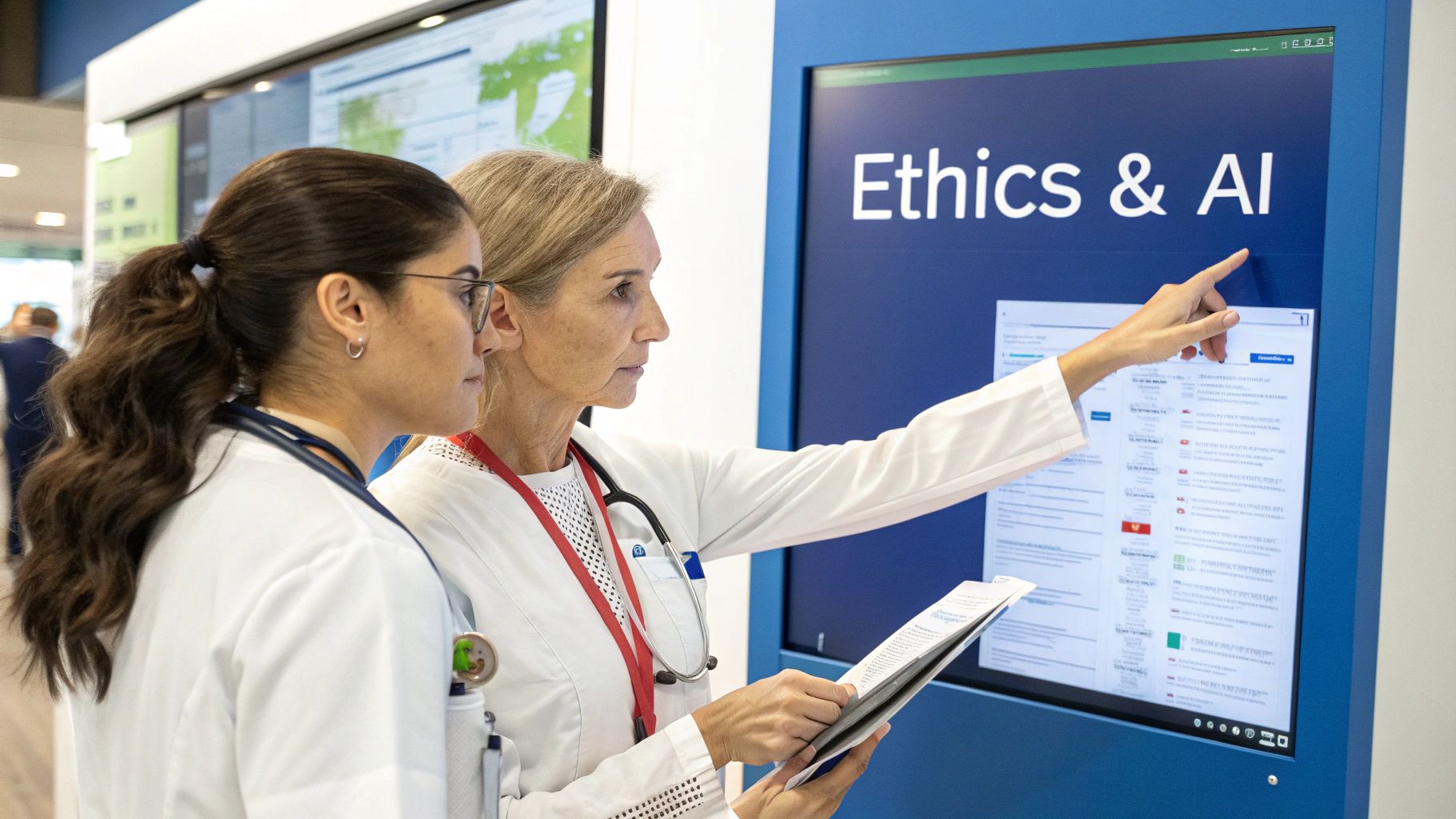
Bringing AI into medtech is far more than a technical challenge; it’s a journey through a dense maze of ethical questions and regulatory hurdles. As these intelligent systems get more involved in patient care, they force us to confront some tough questions.
Who’s on the hook when an AI diagnostic tool gets it wrong? How can we be certain the algorithms guiding life-or-death decisions are fair and unbiased?
These aren't just philosophical thought experiments. They are real-world obstacles that medtech companies, healthcare providers, and Canadian regulators need to navigate carefully. Finding the right balance between innovation and safety is the only way AI will earn the trust it needs to truly succeed in our healthcare system.
Canada's Evolving Regulatory Framework
The Canadian government is working to lay down some ground rules that foster AI innovation while keeping patients safe. A major step was the proposed Artificial Intelligence and Data Act (AIDA), which was designed to create a clear playbook for AI development. But with the regulatory landscape still taking shape, everyone involved needs to keep a close watch.
The rapid spread of AI in Canadian healthcare is a double-edged sword. A 2025 report from Canada’s Drug Agency points to AI's incredible potential to boost efficiency and improve patient outcomes. At the same time, it raises red flags about clinicians using complex tools without formal approval or proper training. With the federal AI framework still in flux after AIDA was put on hold, government bodies are leaning on advisory councils and voluntary codes to steer responsible adoption. The message is clear: proceed with caution to manage liability and protect patients.
For medtech innovators, this means a few things are non-negotiable:
-
Transparency: You have to be able to show your work, how your AI models were built, trained, and validated.
-
Risk Management: It's about looking around the corner to spot and deal with potential problems, from data breaches to faulty recommendations.
-
Compliance: You must stay on top of the ever-changing provincial and federal rules around data privacy and medical device certification.
The Critical Issue of Algorithmic Bias
One of the biggest ethical headaches with AI in medtech is algorithmic bias. At its core, an AI model is a reflection of the data it learns from. If that data doesn't accurately represent everyone, the AI won't work for everyone.
Think about it this way: an AI tool designed to spot skin cancer might be trained almost exclusively on images of lighter skin. The result? It could be far less effective at detecting melanoma in patients with darker skin, creating a dangerous gap in health equity. Fixing this isn't an afterthought; it requires a deliberate, focused effort to train and test models on datasets that are diverse and truly representative of the entire population.
Algorithmic fairness isn't just a technical spec; it's a moral imperative. To build trust, AI systems in healthcare must be proven to work effectively and equitably for every single patient, regardless of their background.
Of course, keeping patient data private and secure is fundamental. This is where other AI-powered solutions, like voice biometrics for secure authentication, can play a vital part by adding strong layers of security to safeguard sensitive health information.
Building Responsible and Trustworthy AI
Ultimately, the aim is to build 'responsible AI' systems that are transparent, fair, and accountable. This goes way beyond just writing clean code. It demands a genuine understanding of the ethical weight of these tools at every single stage of development. If you're looking to get a better handle on these core principles, our guide on the ethics and AI in healthcare is a great place to start.
Earning that trust means putting solid guardrails in place. For developers and hospitals alike, this means having clear lines of accountability for AI-driven decisions and always, always keeping a "human in the loop" for the most critical clinical judgments. By facing these ethical challenges head-on, we can make sure that AI in medtech delivers on its promise to improve health for all Canadians, safely and fairly.
A Practical Roadmap for AI Adoption
So, you see the potential of AI in medtech, but the leap from concept to reality feels massive. It doesn't have to be. With a thoughtful, human-first strategy, you can break down this complex process into manageable steps. The journey doesn't start with the flashiest tech; it starts by figuring out what problem you actually need to solve.
Instead of getting swept up in the latest AI hype, take a good look at your own operations. Where are the real sticking points in your clinical or administrative workflows? Maybe long diagnostic wait times are causing a major bottleneck. Perhaps your team is drowning in paperwork. By zeroing in on a specific, high-impact problem, you give your AI initiative a clear purpose.
This focused approach does two things: it ensures the technology serves a genuine need and makes it far easier to get your staff on board and show real results quickly.
Assembling the Right Team and Technology
Once you've defined the problem, it's time to build your team and find the right tools. This isn't just about hiring a vendor. You need internal champions, a cross-functional group of clinicians, IT specialists, and administrators who understand the day-to-day realities and can see how a new tool will fit into the bigger picture.
Choosing an external technology partner is just as critical. You need someone who gets healthcare, understands the nuances of data privacy regulations, and is willing to work with you. Think of them less as a supplier and more as a co-pilot invested in your success. For organizations looking to create something from the ground up, teaming up with specialists in data science and AI development can bring the deep expertise needed to build a tool that’s just right.
"The most successful AI implementations aren't just about plugging in new software. They are about co-creating solutions that fit seamlessly into existing clinical workflows, augmenting the skills of healthcare professionals without causing disruption."
Before you can even think about deployment, you have to get your data house in order. This is a foundational step you absolutely cannot skip. An AI is only as smart as the data it’s trained on, which means your data needs to be clean, organized, and accessible. This might mean investing some time in standardizing formats or making sure different systems can actually talk to each other.
Fostering Trust Through Training and Transparency
You could have the most advanced AI on the planet, but it's worthless if your team doesn't trust it or know how to use it. A truly human-centred rollout puts training and clear communication front and centre from day one.
And this training needs to be more than just a quick software tutorial. It has to cover the why; why this tool is being brought in, a basic rundown of how it works, and how it will specifically make life better for both staff and patients. Being transparent like this helps pull back the curtain on the technology, building the confidence your team needs to embrace it.
For a smoother transition, keep these steps in mind:
-
Start with a Pilot Program: Don't go all-in at once. Test the AI solution in a controlled setting with a small, dedicated group. This lets you iron out the kinks before a full-scale launch.
-
Establish Clear Governance: Set up straightforward guidelines for how the tool should be used. This includes clear protocols for when a human expert should step in and override an AI recommendation.
-
Gather Continuous Feedback: Open up channels for staff to share their thoughts and experiences. This not only makes them feel like part of the process but also provides invaluable insights for refining the system over time.
By putting people first, solving their problems, and giving them the training to succeed, healthcare organizations can confidently navigate the road to AI adoption. This practical approach ensures that AI in medtech truly becomes a powerful ally, leading to better efficiency and, most importantly, better patient care.
What Does the Future of Healthcare Look Like with AI?
As we peer over the horizon, the next wave of AI in medtech isn't just about making things a little better; it's about fundamentally changing the game. We're moving away from simply enhancing what doctors already do and starting to redefine what's even possible in medicine.
This isn't just a minor upgrade. It’s a complete shift in thinking, moving us from a system that reacts to sickness to one that is truly proactive. We're on the cusp of a reality where intelligent systems can see our health needs coming, sometimes even before we do.
From One-Size-Fits-All to Hyper-Personalized Medicine
One of the most profound shifts on the way is what we call hyper-personalized medicine. Think about treatments designed not for the average person, but specifically for you; your unique genetic code, your lifestyle, your environment. AI algorithms are getting incredibly good at crunching massive genomic datasets to predict how you’ll respond to a certain drug, letting doctors pick the right therapy right from the start.
This approach will slash the frustrating trial-and-error period that comes with so many treatments today, leading to fewer side effects and better results. On top of that, AI is supercharging drug discovery itself. By analyzing molecular structures at a speed and scale no human could ever match, it's poised to get new, life-saving therapies to patients years faster than we can now.
The future of healthcare is a collaborative partnership. It’s not about AI replacing clinicians, but about human expertise guiding powerful intelligent systems to build a more proactive, efficient, and equitable healthcare system for all Canadians.
The Rise of the Digital Twin
Here's a concept straight out of science fiction that's quickly becoming a reality: the "digital twin." This is a dynamic, virtual model of a patient: a living, breathing simulation that constantly updates itself with real-time health data from wearables and sensors.
Imagine a doctor being able to test a new cancer treatment or simulate a complex heart surgery in a completely safe, virtual space before ever making a single incision. That's the power of a digital twin. It gives surgeons and specialists an unprecedented level of precision for planning procedures and predicting exactly how a person’s body will react to an intervention.
This blend of human skill and intelligent technology is what holds the key to a healthier future. By embracing this powerful partnership, we're not just building a smarter healthcare system, but one that’s more compassionate and accessible for everyone.
Common Questions About AI in MedTech Answered
As AI finds its way into more corners of the medical world, it’s completely natural for patients, doctors, and healthcare leaders to have questions. Let's tackle some of the most common ones to clear up any confusion about this exciting field.
Will AI Replace Doctors and Nurses?
This is probably the biggest question on everyone's mind, and the answer is a firm no. The point of bringing AI into healthcare isn't to replace the experience, empathy, and gut instinct of a seasoned professional. It’s meant to be a powerful partner.
Think of it like this: AI is the ultimate assistant. It can tirelessly sift through thousands of medical images, organise complex patient data, and spot patterns humans might miss. This handles the tedious, data-intensive work, freeing up clinicians to do what they do best: connect with patients, make tough judgment calls, and deliver compassionate care.
How is Patient Data Kept Safe and Private?
Protecting patient privacy isn't just a good idea; it's the law. In Canada, any technology that handles health information has to meet strict federal and provincial privacy regulations, like the Personal Information Protection and Electronic Documents Act (PIPEDA).
To keep your sensitive data locked down, medtech solutions use several layers of security:
-
Data Encryption: Your information is scrambled into an unreadable code, both when it's being stored and when it's sent from one place to another.
-
Anonymisation: When data is used to train AI models, all personal details that could identify you are stripped away. This keeps your privacy intact.
-
Access Controls: Only authorised medical staff with a legitimate need can access patient files. Strict rules are in place to control who sees what.
Can We Trust AI to Make Medical Decisions?
Trust in AI isn't a given; it has to be earned. That happens through rigorous testing, being transparent about how the technology works, and always keeping a human expert in charge. Before any AI tool is used on real patients, it goes through exhaustive validation to prove it's safe and effective.
It's vital to remember that AI is built to support decisions, not make them. An algorithm might flag a worrying spot on a scan or suggest a treatment path, but the final call always belongs to a qualified healthcare professional. They bring the broader context, experience, and human touch that no machine can replicate.
This combination of AI's analytical strength and a doctor's real-world wisdom is where the magic really happens.
At Cleffex Digital Ltd, we build secure, compliant, and forward-thinking software solutions that help healthcare organisations bring AI into their practice responsibly. Find out how we can help with your digital journey by visiting our website.
